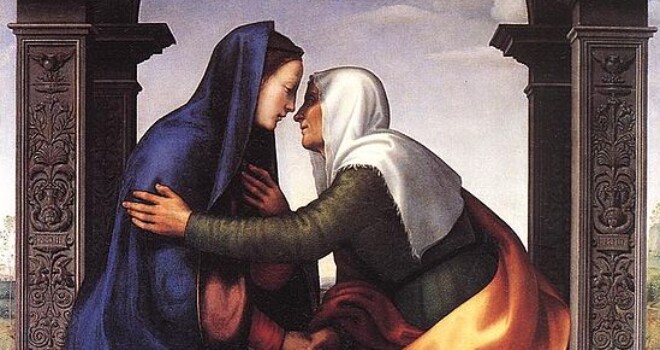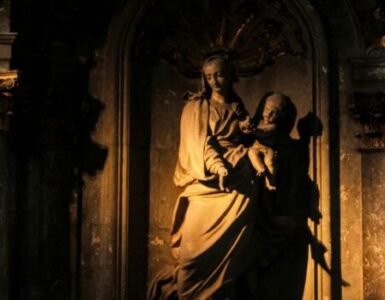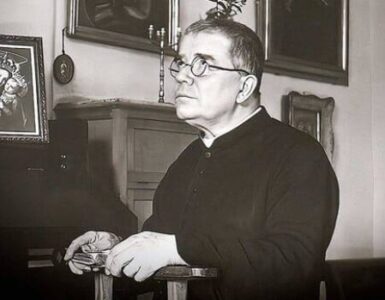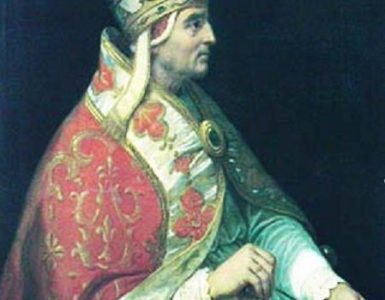Mary remained with Elizabeth about three months and then returned to her home.
So ends the Gospel narrative today. I always find it curious when a powerful scene in the Gospel is followed by what appears to be an insignificant, rather unremarkable addendum that seems to be placed there simply to wrap up the passage. Here Mary has just finished proclaiming “the greatness of the Lord” and exalting His mercy in one of the most brilliant Scriptural acclamations of all time. Scores of books, hymns, and prayers have been produced throughout the centuries based on this one oration, which even has a title: “Magnificat.” And yet, the story comes to an abrupt end, summing up the next three months in a single sentence. No popular hymns have been written about Luke 1:56. No prayer, no books, no made-for-TV movies. So we have to ask ourselves, for what purpose is it included as the conclusion to the longest scriptural exhortation we will ever hear offered to us by our Blessed Mother?
From everything we can surmise about Mary, she would have been a woman of few words. We know she was a humble “handmaid of the Lord,” she was obedient to all that God asked of her, and she pondered the things of God in her heart. That all would have taken an enormous amount of listening, and very little speaking. In fact, in the scant episodes recorded in Scripture in which Mary speaks, there is an intentional purpose to the words she says. Her words lead us to a deeper understanding of God as our Father, the Holy Spirit as her spouse, and Jesus as our Savior:
How can this be…? (Lk 1:34)
Behold, I am the handmaid of the Lord. May it be done to me according to your word. (Lk 1:38)
My soul proclaims the greatness of the Lord… (Lk 1:46-56)
Son, why have you done this to us?… Did you not know that I must be in my Father’s house? (Lk 2:48-49)
Do whatever he tells you. (Jn 2:5)
It is likely that very few words were exchanged between Mary and Elizabeth in the three months that followed their greeting. Scripture highlights for us the only words we need to know about what Mary has to say to Elizabeth, and so our lens into their time together ends there. No more details are we given, no more recorded knowledge of their visit. What conversation might have transpired between the two, we can only imagine.
What does this tell us? It tells us that what is significant for us to know is simply the fact that Mary stayed for three months, and not the precise details of what took place during that time. But there is a lot to unpack in that “little” fact, which, as we will see, is not so insignificant after all.
First, Mary stayed. She didn’t complete her biblical mission of proclaiming the Magnificat and then hightail it out of there. It is true, when God asked her to do something, she would do it “in haste”; but that does not mean she acted hastily, as in, a frantic rush, running from one person to another. It simply means that she was prompt. But Mary also would have given her time and attention to the one she was with—so much so that her penetrating love would have made that soul feel as if they were the only one who mattered to her in that moment. May we ourselves strive to love others with that same kind of time and attention. Mary, teach us to love as you do.
Secondly, Mary stayed three months—not two, not four. Years ago, when I was pregnant with my twins, the doctor put me on what my friends called “house arrest.” Because my pregnancy was considered high-risk, the doctor wanted me to lay low during my last trimester. My mom came to stay with me to help. There wasn’t much for her to do in the weeks leading up to their arrival, but after the twins were born, that’s when I really needed help. So she stayed for one more month . . . the period of time when I actually could have used three! Now if Joseph gave Mary the okay to visit Elizabeth for three months to offer a little help, why not have her go a bit later, so she could stay to help after the baby was born, when help would most be needed? Because while Mary, in her generosity and spirit of service, would certainly have helped Elizabeth as best she could, Scripture does not tell us that helping Elizabeth was the purpose of her visit.
If Elizabeth was six months pregnant when Mary arrived, and we do the math . . . that tells us that Mary left once John was born. Mary was to stay with Elizabeth to witness John’s birth, and, it is quite possible, to deliver the baby herself! And if that is the case, then the very first hands that would have touched the head of the precursor would have been the hands of the one carrying the Child whom John was destined to herald. Jesus, through Mary, would have imposed by her hand a blessing—immediately and without “haste”—upon John’s forehead, the very moment he entered this world.
Once Mary’s mission was completed, she “returned to her home.” There is a tendency we have when enjoying a spiritual consolation to linger with it. The birth of John must have been a moment of incredible joy for both women. The birth of a child tends to get a woman’s oxytocin “bonding” hormone going anyway, but this was the prophet destined to herald the King! The Jews had been waiting for centuries, and now that moment has begun. We can only imagine the eager excitement and anticipation these two women must have surely felt. Not to mention how hard it must have been for them to say goodbye. When it was time for my mother to leave after helping me with my twins, I was heartbroken to see her go. And she too was so sad to leave. I wanted to beg her to stay! But then her visit would have gone beyond the “prescribed” time, and when we do that, we take time away from what we—and the one we are with—are supposed to be doing next. Elizabeth was now to tend to John, and Mary was to return to Joseph.
It was now time for Mary and Joseph to prepare for the coming of the Messiah, the one whose sandals John was not worthy to untie. Now was the time for Joseph and Mary to pray and make ready for the biggest event in salvation history that the world would ever know.
Author’s Note: If you’d like to read more reflections like this one, check out my newest release in The Safe Haven series, The Liturgical Seasons of Advent and Christmas, available from Amazon and The Catholic Store.
Image from Wikimedia Commons












